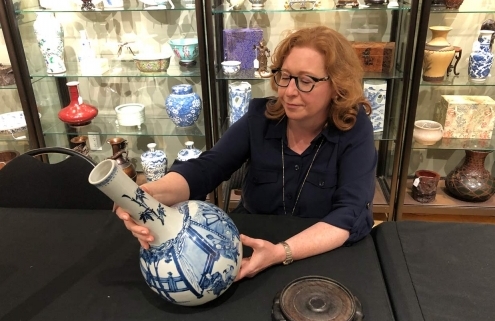Not The Antique Roadshow: Myth Busting about Appraising Art
As a professional art appraiser, I get asked the question daily: ” How much is this worth?” And while this may seem like a simple inquiry that can be answered quickly based on a visual inspection of age, artist, medium, and condition of a specific decorative or fine work of art, in fact, there are numerous factors and methodology required to answer accurately. As well as a lot of myth busting.
The Antiques Roadshow, while entertaining to watch, does not convey the complex process of appraising art or create realistic expectations of what appraisers do. It gives an almost magical illusion that experts pick numbers out of thin air to the delight of amazed owners.
Here are some of the most common myths I regularly encounter:
Myth #1
Old items are always more valuable than newer items. Just because an item is a thousand years old, doesn’t automatically translate to a high value. Buyers decide what is desirable in the market. For Example, back in the late 1970’s and 80’s, interior designers often included Tang dynasty ceramic horses (dating to the 10th century AD) in homes. Wealthy clients paid top dollar for late tri-coloured glazed horses, sometimes upwards of $30,000. In today’s market, however, because they are not currently popular, the seller would likely get significantly less. The same goes for signed works of art. Value depends on whether the artist has an established market, and factors such as subject matter, rarity and provenance. An Andy Warhol limited edition lithograph print might be”worth”m more than an older original oil painting by a lesser-known artist.
Myth #2
There is only one monetary value for an item. In fact, there can potentially be six or more different values for the same work of art depending on the purpose of the appraisal. Values typically rand from the low end for probate tax purposes to the highest for insurance replacement cost. There are more values in between, such as auction value and Fair Market Value for donation or equitable distribution in divorces. Sometimes a piece has more sentimental value than monetary value for an owner. Sadly, appraisers can’t take personal feelings into the equation when estimating value. Appraisers provide an unbiased opinion based on facts. Appraising is an art, not a science, but it has definite criteria and appraisal theory that is applied to reach accurate value conclusions.Viewers can be mislead watching a TV appraisal program when a dollar amount is announced as a value, if they don’t understand there are many ways of answering the question what a piece is ‘worth.’
Myth #3:
Anyone can be an art appraiser. Technically any person walking down the street can offer an opinion on your work of art, but how much confidence can you have in that opinion? Guessing isn’t good enough. Qualified art appraisers belong to recognized appraisal organizations such as the International Society of Appraisers, the American Appraisers Association, or the American Society of Appraisers. Like doctors, electricians and other professionals, appraisers must meet qualification standards of formal education and experience to be a member of these organizations. He/she must pass exams, including the Uniform Standards of Appraisal Practices (USPAP) to ensure a level of competence in the art appraisal field. Professional credentials are based on testing and successful course completion. Fortunately for clients, awareness of the importance of hiring qualified appraisers is growing. The Canada Revenue Agency now suggests that individuals and institutions hire qualified appraisers, and lawyers, banks and insurance companies also recognize the expertise of professional appraisers as resources. Whether it is a Group of Seven painting or a collection of Coca-Cola memorabilia; a Qing dynasty Chinese ink and colour scroll painting or a Lalique glass vase, another consideration when hiring an appraiser is to find someone who specializes in appraising a particular type of artwork. Experts are familiar with items that are faked (items made with the intention to deceive) and specific markets. In other words, don’t ask an appraiser who is an expert in French furniture to value your Greek coins. A good appraiser wouldn’t accept an assignment outside of their field.
Myth #4
Appraisals are free. Appraisals are not free, whether they are verbal or written. Unfortunately, people expect appraisers to give information away, like on the Antiques Roadshow. Research is required, which takes time. An appraiser should charge according to the time necessary to inspect, research and prepare a report, but never according to its potential value. It’s unethical for an appraiser to charge a percentage of the value. Each individual appraiser sets her/his own rates, as there is no official standard hourly rate. A professional services agreement should be signed by both parties outlining the scope of work, fee payment and other critical information to ensure objective, satisfactory results. While we all hope our works of art are treasures just waiting to be discovered, appraising is a complex task. The next time you are watching the Antiques Roadshow, enjoy it, but remember what it is: entertainment with a splash of education. In real life, there are professional appraisers available to help guide you through the process of learning what your works of art are truly ‘worth.’
Susan Lahey, MA, ISA CAPP, is a professional art appraiser specializing in Asian art. She provides independent art research, advisory, collection management, teaching and public speaking services.
Susan writes the Art Buzz column for the East Gwillimbury’s Bulletin Magazine
Need a piece appraised? Contact Susan here










Leave a Reply
Want to join the discussion?Feel free to contribute!